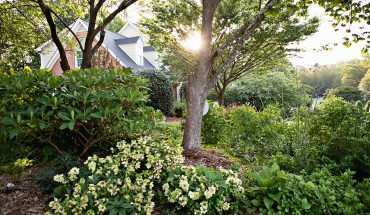
To the right of the front entrance, a sculpture by Raleigh sculptor Paris Alexander welcomes visitors.
by Jesma Reynolds
photographs by Catherine Nguyen
When a Raleigh couple went looking for their ideal vacation home in Asheville, they imagined a log cabin deep in the woods. What they found instead was a mid-century modern five minutes from downtown with spectacular views of the Blue Ridge Mountains. The wife, a noted decorator and shop owner, was quick to grasp the exceptional qualities of the contemporary house, situated on a beautifully flat three-plus-acre lot and designed by the late Bert King, one of Asheville’s most prolific and prominent mid-century architects.
“I can walk into a house in Asheville and immediately recognize it’s by him,” she says. Theirs is a prime example. King “was a classic modernist who tended to design mid-size houses, taking advantage of the great views,” says George Smart, founder and executive director of Durham-based North Carolina Modernist Houses. Clean lines, an intention to bring the outdoors in, and natural materials of wood and stone are all hallmarks of a King residence. A 1949 graduate of N.C. State’s School of Design, King and his firm were widely known for commercial projects including the award-winning design of Warren Wilson Presbyterian Church and College Chapel in Swannanoa, built in 1964. And even though he designed houses more for his own enjoyment than for the income they generated, King’s 40-plus-year career resulted in forward-thinking homes all over Asheville that bear his signature style.

In the entry hall, a Murano glass sculpture commands attention. The paneled wall is stained to mimic Danish teak.
It’s a style the owners were eager to embrace. Most of the changes they’ve made since purchasing the house in 2008 have aimed to honor the architect’s original vision. “Everything is oriented to the view,” says the wife. “This man was a genius.” From hefty stained ceiling beams embedded in a soaring A-frame ceiling to streamlined flat-front kitchen cabinets, almost everything is original. All of the walls have been painted a bright gallery white to allow the architecture and the art (mostly local) to take center stage. In a prominent corner of the largest room – a combined dining and living space that opens to a deck and pool – a bank of floor-to-ceiling windows has replaced an obtrusive bar and tiny windows that the wife guesses must have been added by previous owners. Views of the ridgeline now intermingle with the room, connecting the interiors to the natural beauty outside.

A modern textured wallpaper grounds an entry wall, where the circular pattern is echoed on the lamp base, pair of poufs, and area rug. “It wasn’t intentional to begin with, but when I started putting art up, my girlfriend came over and said ‘So, you’re doing circles,’ I said, ‘Oh, I guess I am.’”
For the wife, who had no prior decorating experience with mid-century interiors, the house became a laboratory for learning about that particular style and movement: “I thought, I’m going for it. I’m going to immerse myself in this. And because I was dealing a little bit in antiques up there, I would talk to dealers who are my friends.” She was committed to featuring vintage pieces as a way to honor the house’s style and because “re-use is the name of the game.” Her aim was to create warm, modern interiors without being too much of a purist. Completed in the later part of King’s career in 1979, the house’s impeccable design made her job easy, she says.

The stone fireplace, ceiling beams, and connection to the outdoors are signature elements of architect Bert King. A pottery bowl by Marsha Owen on the dining table came from the Mahler Gallery in Raleigh. The encaustic paintings above the sectional sofa is by Asheville artist Constance Williams.

The kitchen, dining, and living spaces merge seamlessly to function as one spacious room. Pocket doors to the left of the kitchen reveal a study that can also function as additional sleeping quarters.
And Asheville itself helped – the city’s thriving arts-and-crafts scene became the owner’s trove for colorful paintings, fiber works, works on paper, and pottery. Her approach was to choose art for specific spaces, not unlike King’s careful placement of houses within a landscape. She also tapped Asheville’s mid-century dealers to locate key objects. In the kitchen, pieces of vintage aqua-green pottery rest atop open stainless shelves where they also get a fair share of use. “We entertain a lot up there, so I’m whipping that stuff out. It’s not just for pretty.” To accommodate “all the bodies” that her three older children bring along as houseguests, there are modern sofa beds in the study and downstairs guest quarters, as well as a pair of beanbag chairs in the boys’ room that contain full-size mattresses that flip out and lay flat. It is functionality at its finest.

A whimsical Rebecca Kinkead painting hangs above a collection of vintage, aqua-green pottery that makes for a pretty arrangement and easy access when entertating. The orientation of the bar and stools faces views of the ridgeline.

A guest room blends cozy quilts, a pair of Robert Patierno woodcuts, and mid-century furniture. The metal birds are by Raleigh artist Bill Hickman.
On the back of the house, a covered porch and sweeping deck are the connectors to the pool, an original feature that had been covered up. From there, one of many paths winds down to a labyrinth garden that encircles a metal sculpture by Raleighite Matt McConnell. It’s one of several works by Raleigh artists the couple have installed. A striking female sculpture by Raleigh sculptor Paris Alexander welcomes visitors by the front door, and a 17-foot earth-cast gyre, completed last summer by Thomas Sayre, emerges organically from the ground at the side of the house. “It’s tall enough to be seen from inside without taking away from the house,” the wife notes.

“I always wanted a black and white room with a shot of red,” says the homeowner. She found the vintage slingchair for the study from a mid-century dealer locally. On the walls are a depiction of a waterfall by Asheville painter Mitchell Lonas and an abstract painting by Santa Fe-based artist Peter Burega.

The boys’ bedroom was originally a master bathroom. “I think King would have understood our need to change the configuration. We were a young family when we bought it,” says the wife.
Through the process of working on the residence, the wife developed a passion for modernism and has since traveled on tours with North Carolina Modernist Houses to Los Angeles and Palm Springs to see more examples of that particular architectural style. Last month, she and her husband hosted a dinner for a group of 35 Mod Squad enthusiasts from NCMH who traveled to Asheville to tour some of its modernist homes. Through the lens of the couple’s King-designed house, guests enjoyed views of the Blue Ridge Mountains and the thoughtful restoration of the residence. “We kept his spirit,” she says.

In the master bedroom, a landscape painting by June Ball hangs above the bed; a watercolor from a hiking trip to England lends color on the opposite wall.

The wife opened up a closet in the master bedroom to create an office nook that looks out on Sayre’s sculpture.






